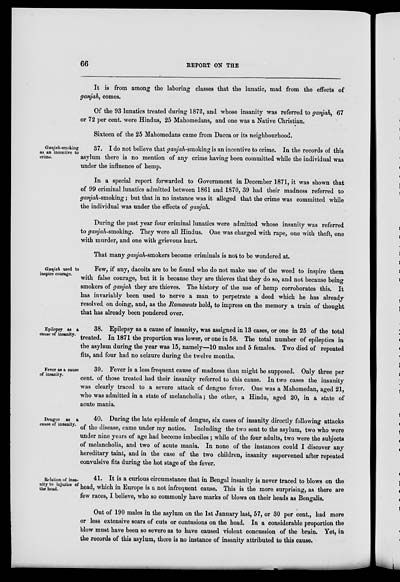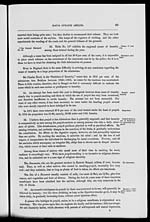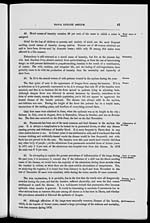Medicine - Mental health > 1867-1924 - Annual report of the insane asylums in Bengal > Insane asylums in Bengal annual reports 1867-1875 > Annual report on the insane asylums in Bengal for the year 1872
(578) Page 66
Download files
Individual page:
Thumbnail gallery: Grid view | List view

66 REPORT ON THE
It is from among the laboring classes that the lunatic, mad from the effects of
ganjah, comes.
Of the 93 lunatics treated during 1872, and whose insanity was referred to ganjah, 67
or 72 per cent. were Hindus, 25 Mahomedans, and one was a Native Christian.
Sixteen of the 25 Mahomedans came from Dacca or its neighbourhood.
Ganjah-smoking
as an incentive to
crime.
37. I do not believe that ganjah-smoking is an incentive to crime. In the records of this
asylum there is no mention of any crime having been committed while the individual was
under the influence of hemp.
In a special report forwarded to Government in December 1871, it was shown that
of 99 criminal lunatics admitted between 1861 and 1870, 39 had their madness referred to
ganjah-smoking; but that in no instance was it alleged that the crime was committed while
the individual was under the effects of ganjah.
During the past year four criminal lunatics were admitted whose insanity was referred
to ganjah-smoking. They were all Hindus. One was charged with rape, one with theft, one
with murder, and one with grievous hurt.
That many ganjah-smokers become criminals is not to be wondered at.
Ganjah used to
inspire courage.
Few, if any, dacoits are to be found who do not make use of the weed to inspire them
with false courage, but it is because they are thieves that they do so, and not because being
smokers of ganjah they are thieves. The history of the use of hemp corroborates this. It
has invariably been used to nerve a man to perpetrate a deed which he has already
resolved on doing, and, as the Ramawats hold, to impress on the memory a train of thought
that has already been pondered over.
Epilepsy as a
cause of insanity.
38. Epilepsy as a cause of insanity, was assigned in 13 cases, or one in 25 of the total
treated. In 1871 the proportion was lower, or one in 58. The total number of epileptics in
the asylum during the year was 15, namely—10 males and 5 females. Two died of repeated
fits, and four had no seizure during the twelve months.
Fever as a cause
of insanity.
39. Fever is a less frequent cause of madness than might be supposed. Only three per
cent. of those treated had their insanity referred to this cause. In two cases the insanity
was clearly traced to a severe attack of dengue fever. One was a Mahomedan, aged 21,
who was admitted in a state of melancholia; the other, a Hindu, aged 20, in a state of
acute mania.
Dengue as a
cause of insanity.
40. During the late epidemic of dengue, six cases of insanity directly following attacks
of the disease, came under my notice. Including the two sent to the asylum, two who were
under nine years of age had become imbeciles; while of the four adults, two were the subjects
of melancholia, and two of acute mania. In none of the instances could I discover any
hereditary taint, and in the case of the two children, insanity supervened after repeated
convulsive fits during the hot stage of the fever.
Relation of insa-
nity to injuries of
the head.
41. It is a curious circumstance that in Bengal insanity is never traced to blows on the
head, which in Europe is a not infrequent cause. This is the more surprising, as there are
few races, I believe, who so commonly have marks of blows on their heads as Bengalis.
Out of 190 males in the asylum on the 1st January last, 57, or 30 per cent., had more
or less extensive scars of cuts or contusions on the head. In a considerable proportion the
blow must have been so severe as to have caused violent concussion of the brain. Yet, in
the records of this asylum, there is no instance of insanity attributed to this cause.
Set display mode to: Large image | Zoom image | Transcription
Images and transcriptions on this page, including medium image downloads, may be used under the Creative Commons Attribution 4.0 International Licence unless otherwise stated. ![]()
| Permanent URL | https://digital.nls.uk/83379734 |
|---|




